Dr Nimai Mishra explores the role of surface chemistry in improving photocatalytic applications
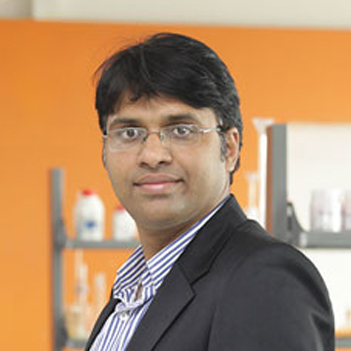 Dr Nimai Mishra, Assistant Professor, Department of Chemistry, SRM University-AP, Andhra Pradesh, along with his research group comprising of students pursuing PhD under him, Mr Syed Akhil and Ms V G Vasavi Dutt have published a research article titled “Surface Modification for Improving Photoredox Activity of CsPbBr3 Nanocrystals” in the Journal “Nanoscale Advances” (The Royal Society of Chemistry).
Dr Nimai Mishra, Assistant Professor, Department of Chemistry, SRM University-AP, Andhra Pradesh, along with his research group comprising of students pursuing PhD under him, Mr Syed Akhil and Ms V G Vasavi Dutt have published a research article titled “Surface Modification for Improving Photoredox Activity of CsPbBr3 Nanocrystals” in the Journal “Nanoscale Advances” (The Royal Society of Chemistry).
Inorganic lead halide perovskite nanocrystals (PNCs) are used in photocatalytic reactions in the modern era. The surface chemistry of the PNCs can play an important role in the excited state interactions and efficient charge transfer with redox molecules. In this work, Dr Mishra’s research group explored the impact of CsPbBr3 nanocrystal surface modification on the excited state interactions with the electron acceptor benzoquinone (BQ) for three different ligand environments: as oleic acid/oleylamine (OA/OAm), oleic acid (OA)/ trioctylphosphine (TOP), and oleic acid (OA)/ oleylamine (OAm)/ trioctylphosphine (TOP) ligands.
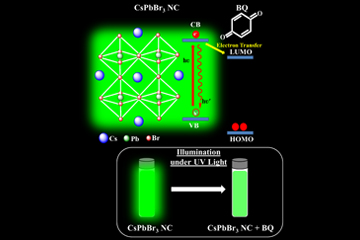 The research infers that amine-free PNCs (OA/TOP capped) exhibit the best-excited state interactions with benzoquinone as compared to the conventional oleylamine ligand environment. The photoinduced electron transfer (PET) rate constants were measured from PL-lifetime decay measurement. The amine-free PNCs show the highest PET which is 9 times higher than conventional ligands capped PNCs. These results highlight the impact of surface chemistry on excited-state interactions of CsPbBr3 NCs and in photocatalytic applications.
The research infers that amine-free PNCs (OA/TOP capped) exhibit the best-excited state interactions with benzoquinone as compared to the conventional oleylamine ligand environment. The photoinduced electron transfer (PET) rate constants were measured from PL-lifetime decay measurement. The amine-free PNCs show the highest PET which is 9 times higher than conventional ligands capped PNCs. These results highlight the impact of surface chemistry on excited-state interactions of CsPbBr3 NCs and in photocatalytic applications.
More importantly, this work concludes that amine-free PNCs maintain a redox-active surface with a high photoinduced electron transfer rate which makes them an ideal candidate for photocatalytic applications.
To read the full paper: Please Click Here
- Published in News, Research News
“Chemists have to play a major role to achieve sustainable development”- opined Prof Lakshmi Kantam in the University Distinguished Lecture Series
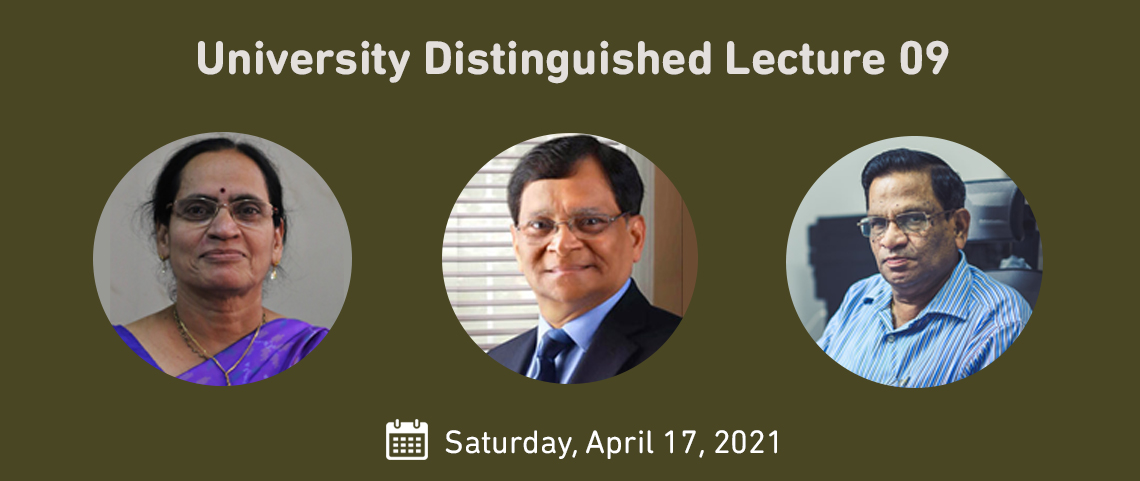 Observing the ninth edition of University Distinguished Lecture Series, SRM University, Andhra Pradesh, invited Prof Lakshmi Kantam Mannepalli, the Dr B P Godrej Distinguished Professor of Green Chemistry, Department of Chemical Engineering, Institute of Chemical Technology, Mumbai, to address a captivating speech on “Design and Development of Homogeneous/Heterogeneous Catalysts for Sustainable Chemical Industry”. Prof D Narayana Rao, Pro Vice-chancellor, inaugurated the talk with a welcome speech. The ceremony was attended by Prof VS Rao, Vice-Chancellor SRMAP and Dr S Mannathan, Department of Chemistry. Prof D Narayana Rao expressed that “Industrial collaboration is very much necessary in the context of self-reliant India (Atma Nirbhar Bharat)”.
Observing the ninth edition of University Distinguished Lecture Series, SRM University, Andhra Pradesh, invited Prof Lakshmi Kantam Mannepalli, the Dr B P Godrej Distinguished Professor of Green Chemistry, Department of Chemical Engineering, Institute of Chemical Technology, Mumbai, to address a captivating speech on “Design and Development of Homogeneous/Heterogeneous Catalysts for Sustainable Chemical Industry”. Prof D Narayana Rao, Pro Vice-chancellor, inaugurated the talk with a welcome speech. The ceremony was attended by Prof VS Rao, Vice-Chancellor SRMAP and Dr S Mannathan, Department of Chemistry. Prof D Narayana Rao expressed that “Industrial collaboration is very much necessary in the context of self-reliant India (Atma Nirbhar Bharat)”.
Advancing with Prof Lakshmi Kanam’s presentation, she added, “Global and Indian chemical industry estimate 5.1 trillion and 108.4 billion USD in 2021. Catalysis is a highly demanded technology for a sustainable society and drives innovation in many other fields. Achieving the high catalytic selectivity is the aim of catalysis science in 21 st century”.
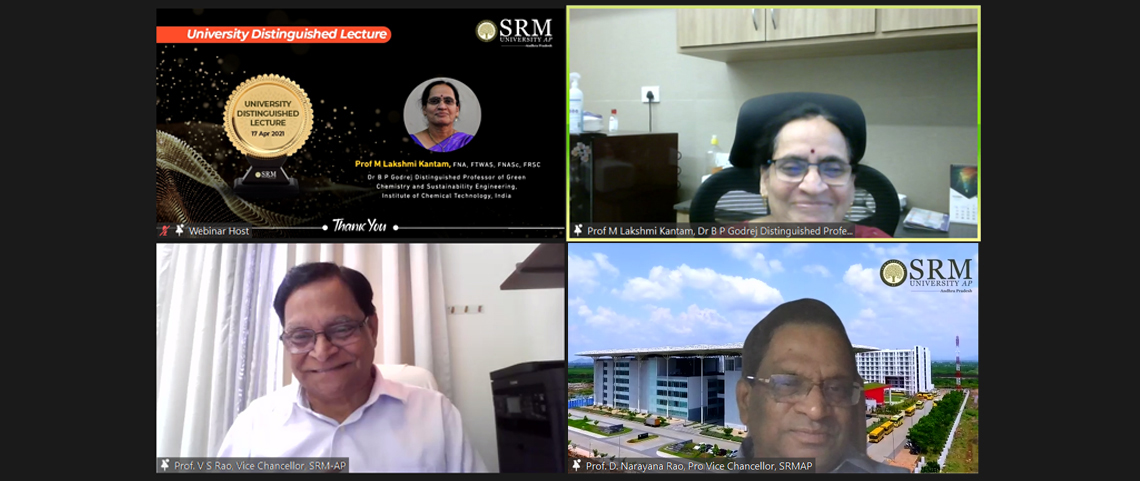 She also stated in her presentation, “The catalysis of organic reactions by homogeneous and heterogeneous catalysts remains a diversified field of scientific inquiry. It attracts a large group of scientists with specialities spanning synthetic organic chemistry, inorganic chemistry, surface science, material science, reaction engineering and computational modelling”.
She also stated in her presentation, “The catalysis of organic reactions by homogeneous and heterogeneous catalysts remains a diversified field of scientific inquiry. It attracts a large group of scientists with specialities spanning synthetic organic chemistry, inorganic chemistry, surface science, material science, reaction engineering and computational modelling”.
As a part of Prof Lakshmi Kantam’ s research study, she briefly explained, “Hydroxyapatite (HA) is a hydrated calcium phosphate material, which is an important biomaterial because of its similarity to the mineral component of mammalian bone. We have utilised these materials, and their metal exchanged materials as catalysts for C-C and C-N coupling reactions. Similarly, hydrotalcite, anionic clays have been exchanged with different metal ions and successfully applied in a number of organic transformations”. An overview of the work on the design and development of catalysts for sustainable, economical process and technologies for the chemical industry was introduced.
Noted personality in the field of Chemical Sciences and Engineering, Prof Lakshmi Kantam holds esteemed titles of FNA, FTWAS, FNASc, FRSC. Her fields of expertise are Catalysis, Materials and Process Chemistry. Prof Lakshmi Kantam served as the Director of CSIR-Indian Institute of Chemical Technology, Hyderabad. Prof. Lakshmi Kantam is Non-Executive Independent Director of Godavari Bio Refineries Ltd, Indo Amines Ltd, Vinati Organics Ltd and several others.
- Published in News, Research Events, Research News, Research Webinars, University Distinguished Lecture, Webinars
An Enthralling Webinar on “Applications of Artificial Intelligence in Aerospace Engineering”
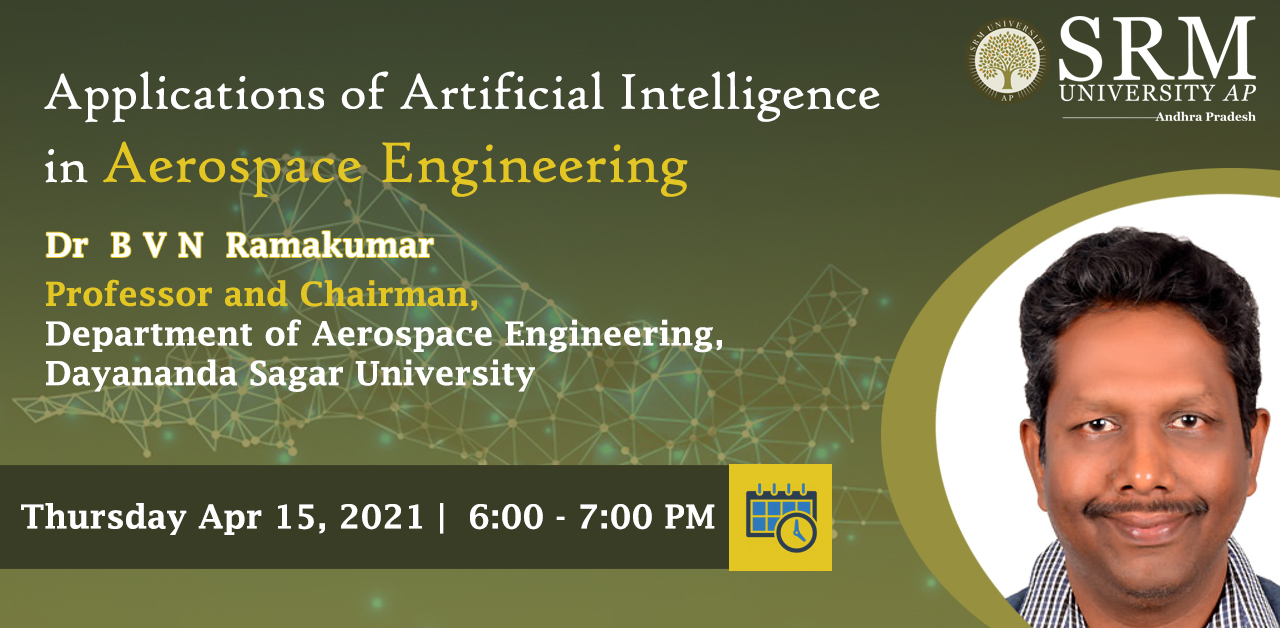 On April 15, 2021, the Department of Mechanical Engineering, SRM University-AP, Andhra Pradesh, hosted a virtual lecture session with Dr B V N Ramakumar, Professor and HOD, Department of Aerospace Engineering, Dayananda Sagar University, Bangalore. Addressing the Webinar, Dr Lakshmi Sirisha Maganti and Dr Venkata Nori, Faculty, Department of Mechanical Engineering, handed over the podium to Dr Ramakumar. Initiating the discussion with a brief understanding of the background of Artificial Intelligence (AI), Dr Ramakumar described the AI Applications in Space, Civil and Defense industry. Apart from highlighting the overview and functionality of AI Applications in Aerospace Engineering, he outlined the challenges associated with it.
On April 15, 2021, the Department of Mechanical Engineering, SRM University-AP, Andhra Pradesh, hosted a virtual lecture session with Dr B V N Ramakumar, Professor and HOD, Department of Aerospace Engineering, Dayananda Sagar University, Bangalore. Addressing the Webinar, Dr Lakshmi Sirisha Maganti and Dr Venkata Nori, Faculty, Department of Mechanical Engineering, handed over the podium to Dr Ramakumar. Initiating the discussion with a brief understanding of the background of Artificial Intelligence (AI), Dr Ramakumar described the AI Applications in Space, Civil and Defense industry. Apart from highlighting the overview and functionality of AI Applications in Aerospace Engineering, he outlined the challenges associated with it.
Dr Ramakumar completed his bachelor’s from Ranchi University, and he pursued a master’s from Andhra University. Dr Ramakumar holds a Doctorate Degree from IIT Madras and has years of experience in research, academia and industry. Dr Ramakumar worked for Rolls Royce India Pvt Ltd and Honeywell Solutions Pvt Ltd. With contributions to the Auto Mechanics Industrial Sector, he also worked for the DMR Institute of Technology.
Dr Ramakumar was the visiting faculty at Manipal University. In terms of contribution to the field of engineering, he designed, developed, and analysed components for Boeing 777X, Airbus A350 and Honeywell HTF700 Engine Programme. Dr Ramakumar published papers in reputed National and International journals in addition to two patents to his credit.
Dr Ramakumar elucidated, “Artificial Intelligence is the broad sphere covering machine learning and deep learning as well. Moreover, a technique which mimics human behaviour”. Discussing the key players in the aviation industry, he explained the role of the mini-robots to capture the imagery clips of the inaccessible area in an aircraft. Implementation of the Artificial Reality techniques in the civil aviation industry is needed to reduce manual cost and time. AI applications manage the supply chain by gathering data as a part of the predictive measure. With the inclusion of automated tools, the civil aviation industry efficiently controls and optimises the security parameters.
During Dr Ramkumar’s proceeding, he added, “AI Application in aviation optimises the data related to flight scheduling, seat arrangement, cabin crew shift scheduling along with the management of the route mapping”. Starting from taking off to landing, AI Applications are being used widely in the aviation industry.
He further added that “Emerging as the dynamic technology, AI Applications marked their presence in the military intelligence too. Drones for military operations map the routes and record that in imagery forms to apprehend the nearby geographical location. The information stored in databases are sent and received without any manual meddling”.
Advancing to the next part of the discussion, Dr Ramakumar explained that “Speaking of the satellite link and communication, Robonauts are the new humanoid robots that would replicate the actual human beings by assisting in anything from gathering outer space information to exploring it”. Dr Ramakumar also propounds that “Productivity and Investment are few challenges amongst others that are common and would go hand in hand with the development of AI technology.” The discussion came to an end with an engaging Q&A session with the students followed by a Vote of Thanks by Dr Nori.
- Published in Departmental News, Mechanical Engineering NEWS, News, Webinars
Undergrad Student research predicts stock market valuations
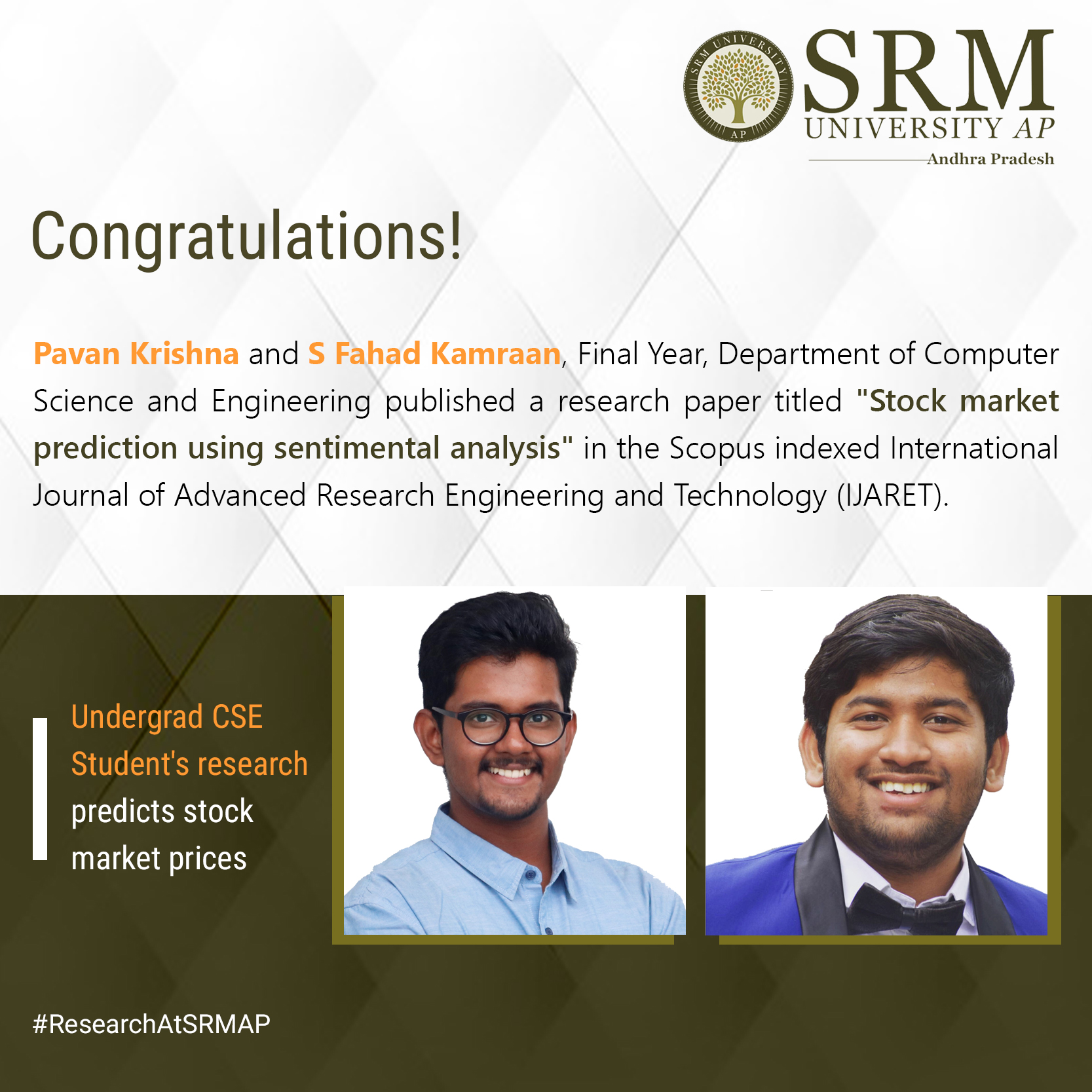 Pavan Krishna and S Fahad Kamraan, guided by Dr Priyanka, Department of Computer Science and Engineering, SRM University-AP, Andhra Pradesh, successfully published a research paper titled “Stock market prediction using sentimental analysis” in the Scopus indexed “International Journal of Advanced Research Engineering and Technology (IJARET)” on March 2021. Being the students of the Department of Computer Science and Engineering, both researchers have apt knowledge on the sentimental analysis commonly known as opinion mining or emotion AI led to the successful execution of the research project.
Pavan Krishna and S Fahad Kamraan, guided by Dr Priyanka, Department of Computer Science and Engineering, SRM University-AP, Andhra Pradesh, successfully published a research paper titled “Stock market prediction using sentimental analysis” in the Scopus indexed “International Journal of Advanced Research Engineering and Technology (IJARET)” on March 2021. Being the students of the Department of Computer Science and Engineering, both researchers have apt knowledge on the sentimental analysis commonly known as opinion mining or emotion AI led to the successful execution of the research project.
Sentimental analysis is used to help find patterns in textual data, to understand people’s emotions and sentiments in a much deeper and holistic way. It is used to find the polarity of the information and to classify it under different emotion/ sentiment radar all the way from sad to happy or too excited.
The key title takes a dig into a study involving a new method of predicting stocks by performing sentimental analysis on the financial data. A sentiment is analysed on the subjectivity and polarity index by classifying it into positive and negative news. Here, to predict the real-time stock price, sentiment analysis measures the polarity or subjectivity score, respectively.
“While pursuing my minor in Business Management, I gained Financial Literacy and eventually found an interest in the Stock Market & its behaviour. At the same time, we noticed how social media plays a crucial role in deciding stock prices. Fahad and I were so intrigued that we decided to take up a Project on Predicting Stock Market Prices based on Sentimental Analysis of statement – News & Tweets”, informed Pavan.
Fahad further acknowledged that the project was a big step for undergraduate students, and it could not have been possible without the guidance and motivation of Dr Priyanka, their mentor. “Dr Priyanka was the constant support and path-bearer for us as she showed immense faith until the goal is achieved”, said Fahad.
The duo was excited after receiving high praises and acclaims for their research project. They look forward to coming up with more research ideas that can benefit society.
- Published in CSE NEWS, Departmental News, News, Research News, Students Achievements

